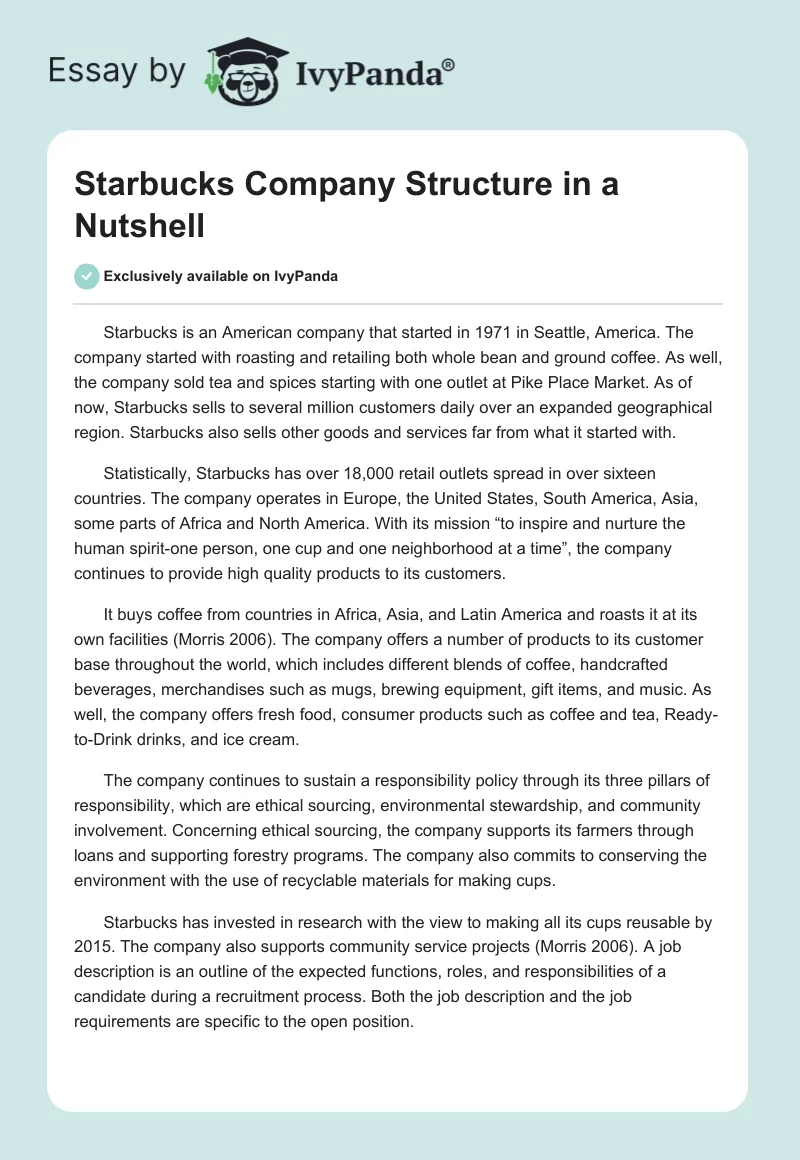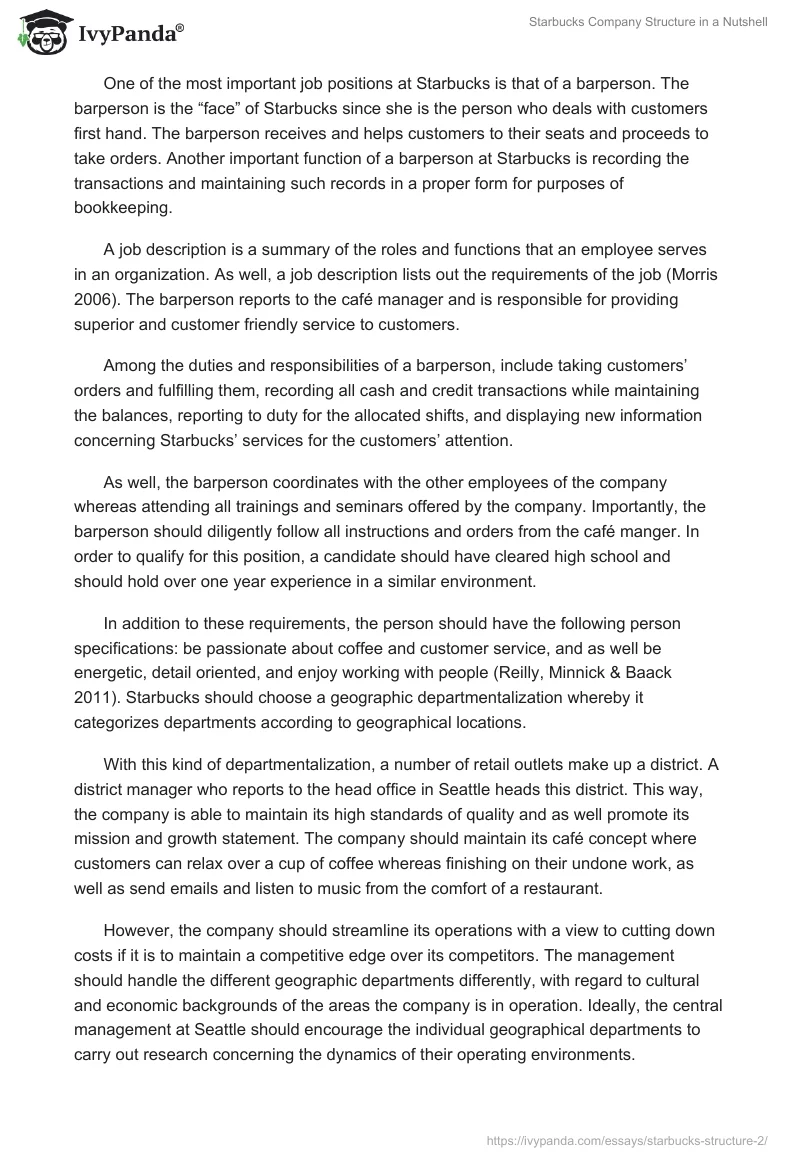Starbucks is an American company that started in 1971 in Seattle, America. The company started with roasting and retailing both whole bean and ground coffee. As well, the company sold tea and spices starting with one outlet at Pike Place Market. As of now, Starbucks sells to several million customers daily over an expanded geographical region. Starbucks also sells other goods and services far from what it started with.
Statistically, Starbucks has over 18,000 retail outlets spread in over sixteen countries. The company operates in Europe, the United States, South America, Asia, some parts of Africa and North America. With its mission “to inspire and nurture the human spirit-one person, one cup and one neighborhood at a time”, the company continues to provide high quality products to its customers.
It buys coffee from countries in Africa, Asia, and Latin America and roasts it at its own facilities (Morris 2006). The company offers a number of products to its customer base throughout the world, which includes different blends of coffee, handcrafted beverages, merchandises such as mugs, brewing equipment, gift items, and music. As well, the company offers fresh food, consumer products such as coffee and tea, Ready-to-Drink drinks, and ice cream.
The company continues to sustain a responsibility policy through its three pillars of responsibility, which are ethical sourcing, environmental stewardship, and community involvement. Concerning ethical sourcing, the company supports its farmers through loans and supporting forestry programs. The company also commits to conserving the environment with the use of recyclable materials for making cups.
Starbucks has invested in research with the view to making all its cups reusable by 2015. The company also supports community service projects (Morris 2006). A job description is an outline of the expected functions, roles, and responsibilities of a candidate during a recruitment process. Both the job description and the job requirements are specific to the open position.
One of the most important job positions at Starbucks is that of a barperson. The barperson is the “face” of Starbucks since she is the person who deals with customers first hand. The barperson receives and helps customers to their seats and proceeds to take orders. Another important function of a barperson at Starbucks is recording the transactions and maintaining such records in a proper form for purposes of bookkeeping.
A job description is a summary of the roles and functions that an employee serves in an organization. As well, a job description lists out the requirements of the job (Morris 2006). The barperson reports to the café manager and is responsible for providing superior and customer friendly service to customers.
Among the duties and responsibilities of a barperson, include taking customers’ orders and fulfilling them, recording all cash and credit transactions while maintaining the balances, reporting to duty for the allocated shifts, and displaying new information concerning Starbucks’ services for the customers’ attention.
As well, the barperson coordinates with the other employees of the company whereas attending all trainings and seminars offered by the company. Importantly, the barperson should diligently follow all instructions and orders from the café manger. In order to qualify for this position, a candidate should have cleared high school and should hold over one year experience in a similar environment.
In addition to these requirements, the person should have the following person specifications: be passionate about coffee and customer service, and as well be energetic, detail oriented, and enjoy working with people (Reilly, Minnick & Baack 2011). Starbucks should choose a geographic departmentalization whereby it categorizes departments according to geographical locations.
With this kind of departmentalization, a number of retail outlets make up a district. A district manager who reports to the head office in Seattle heads this district. This way, the company is able to maintain its high standards of quality and as well promote its mission and growth statement. The company should maintain its café concept where customers can relax over a cup of coffee whereas finishing on their undone work, as well as send emails and listen to music from the comfort of a restaurant.
However, the company should streamline its operations with a view to cutting down costs if it is to maintain a competitive edge over its competitors. The management should handle the different geographic departments differently, with regard to cultural and economic backgrounds of the areas the company is in operation. Ideally, the central management at Seattle should encourage the individual geographical departments to carry out research concerning the dynamics of their operating environments.
This should be with a view to identifying the strengths, weaknesses, and opportunities for growth for each operating environment (Reilly, Minnick & Baack 2011). In the event that the company experiences financial problems, the company should adopt a twofold strategy in terms of decision-making and the exercise of power. The company should both apply decentralization and centralization of power appropriate to individual cases.
First, the head office must ensure that every geographic department meets its strict and ambitious goals and objectives. All geographical departments should adhere to the financial and operational directives of the corporate office. As well, they must maintain quality at an all time high. The corporate office should see to it that all retail outlets follow its directives and operational procedures.
On the other hand, each geographic department must be responsible for its own success. Every department should align its marketing objectives to the specific geographical consumer demands but within the wider view of the Starbucks’ corporate brand image. The geographic department must understand the unique customer characteristic specific to the region, and align its strategies towards meeting and sustaining the demands of its customers.
This way all the geographical regions remain attached to the headquarters and conform to the company’s corporate standards (Reilly, Minnick & Baack 2011). In order to increase efficiency and reduce costs, the company should automate its service line. The company should automate its service delivery activities in order to save on costs whereas reducing the service time for its customers.
Currently, Starbucks is operating at high costs causing it to charge more for its services. By mechanizing and automating the whole value chain process, Starbuck will have a competitive advantage over its competitors since it will be able to charge less. This way, the company will be able to increase and sustain its market share and in which way operate profitably.
The company should also standardize its norms so that every employee of the company is able to follow and individually drive the company’s corporate objectives. The head office should devise standardized training programs for all employees of the company. In order to achieve this, a team of experts from the headquarters should drive these training programs (Reilly, Minnick & Baack 2011).
References
Morris, T. (2006, September 1) Understanding Starbucks. Coriolis Research. Web.
Reilly, M., Minnick, C., & Baack, D. (2011). The Five Functions of Effective Management. San Diego, CA: Bridgepoint Education Inc.


